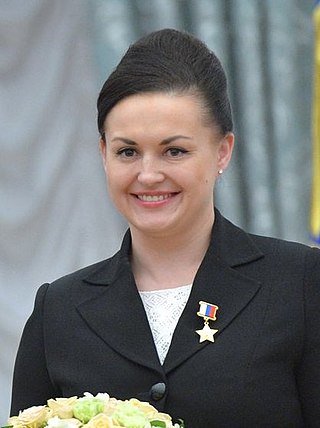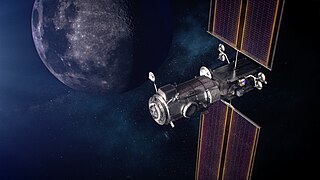Related Research Articles

Human spaceflight is spaceflight with a crew or passengers aboard a spacecraft, often with the spacecraft being operated directly by the onboard human crew. Spacecraft can also be remotely operated from ground stations on Earth, or autonomously, without any direct human involvement. People trained for spaceflight are called astronauts, cosmonauts (Russian), or taikonauts (Chinese); and non-professionals are referred to as spaceflight participants or spacefarers.

The Space Race was a 20th-century competition between two Cold War rivals, the United States and the Soviet Union, to achieve superior spaceflight capability. It had its origins in the ballistic missile-based nuclear arms race between the two nations following World War II and had its peak with the more particular Moon Race to land on the Moon between the US moonshot and Soviet moonshot programs. The technological advantage demonstrated by spaceflight achievement was seen as necessary for national security and became part of the symbolism and ideology of the time. The Space Race brought pioneering launches of artificial satellites, robotic space probes to the Moon, Venus, and Mars, and human spaceflight in low Earth orbit and ultimately to the Moon.
Human spaceflight programs have been conducted, started, or planned by multiple countries and companies. The age of manned rocket flight was initiated by Fritz von Opel who piloted the world's first rocket-propelled flight on 30 September 1929. All space flights depend on rocket technology; von Opel was the co-designer and financier of the visionary project. Until the 21st century, human spaceflight programs were sponsored exclusively by governments, through either the military or civilian space agencies. With the launch of the privately funded SpaceShipOne in 2004, a new category of human spaceflight programs – commercial human spaceflight – arrived. By the end of 2022, three countries and one private company (SpaceX) had successfully launched humans to Earth orbit, and two private companies had launched humans on a suborbital trajectory.

Robert Brent "Bob" Thirsk, is a Canadian retired engineer and physician, and a former Canadian Space Agency astronaut. He holds the Canadian record for the most time spent in space. He became an officer of the Order of Canada (OC) in 2013 and was named to the Order of British Columbia (OBC) in 2012.

The Shuttle–Mir program was a collaborative 11-mission space program between Russia and the United States that involved American Space Shuttles visiting the Russian space station Mir, Russian cosmonauts flying on the Shuttle, and an American astronaut flying aboard a Soyuz spacecraft to engage in long-duration expeditions aboard Mir.

Nauka, also known as the Multipurpose Laboratory Module-Upgrade or simply Multipurpose Laboratory Module (MLM), is a module of the International Space Station (ISS). The MLM-U is funded by Roscosmos. In the original ISS plans, Nauka was to use the location of the Docking and Storage Module (DSM). Later, the DSM was replaced by the Rassvet module and Nauka was moved from Zarya's nadir port to Zvezda's nadir port.

A space capsule is a spacecraft designed to transport cargo, scientific experiments, and/or astronauts to and from space. Capsules are distinguished from other spacecraft by the ability to survive reentry and return a payload to the Earth's surface from orbit, and are distinguished from other types of recoverable spacecraft by their blunt shape, not having wings and often containing little fuel other than what is necessary for a safe return. Capsule-based crewed spacecraft such as Soyuz or Orion are often supported by a service or adapter module, and sometimes augmented with an extra module for extended space operations. Capsules make up the majority of crewed spacecraft designs, although one crewed spaceplane, the Space Shuttle, has flown in orbit.

A Moon landing or lunar landing is the arrival of a spacecraft on the surface of the Moon. This includes both crewed and robotic missions. The first human-made object to touch the Moon was the Soviet Union's Luna 2, on 13 September 1959.

The MARS-500 mission was a psychosocial isolation experiment conducted between 2007 and 2011 by Russia, the European Space Agency, and China, in preparation for an unspecified future crewed spaceflight to the planet Mars. The experiment's facility was located at the Russian Academy of Sciences' Institute of Biomedical Problems (IBMP) in Moscow, Russia.

Spaceflight began in the 20th century following theoretical and practical breakthroughs by Konstantin Tsiolkovsky, Robert H. Goddard, and Hermann Oberth. First successful large-scale rocket programs were initiated in the 1920s Germany by Fritz von Opel and Max Valier, and eventually in Nazi Germany by Wernher von Braun. The Soviet Union took the lead in the post-war Space Race, launching the first satellite, the first man and the first woman into orbit. The United States caught up with, and then passed, their Soviet rivals during the mid-1960s, landing the first men on the Moon in 1969. In the same period, France, the United Kingdom, Japan and China were concurrently developing more limited launch capabilities.

Yelena Olegovna Serova is a Russian politician and former cosmonaut. She served as a Deputy in the State Duma of Russian Federation between 2016 and 2021.

Oleg Dmitriyevich Kononenko is a Russian cosmonaut. He has flown to the International Space Station five times, as a flight engineer for Expedition 17 aboard Soyuz TMA-12, as a flight engineer on Expedition 30 and commander of Expedition 31 aboard Soyuz TMA-03M, as a flight engineer on Expedition 44 and Expedition 45 aboard Soyuz TMA-17M, and as commander of Expedition 58 and Expedition 59 aboard Soyuz MS-11 and Expedition 70 and Expedition 71 aboard Soyuz MS-24/MS-25.

The LK was a lunar module developed in the 1960s as a part of several Soviet crewed lunar programs. Its role was analogous to the American Apollo Lunar Module (LM). Three LK modules, of the T2K variant, were flown without crew in Earth orbit, but no LK ever reached the Moon. The development of the N1 launch vehicle required for the lunar flight suffered setbacks, and the first Moon landings were achieved by US astronauts on Apollo 11. As a result, having lost the Space Race, both the N1 and the LK programs were cancelled without any further development.

Orel or Oryol, formerly Federation, and PPPTS, is a project by Roscosmos to develop a new-generation, partially reusable crewed spacecraft.

The Lunar Gateway, or simply Gateway, is the first planned extraterrestrial space station. It will be placed in lunar orbit and is intended to serve as a solar-powered communication hub, science laboratory, and short-term habitation module for government-agency astronauts, as well as a holding area for rovers and other robots. It is a multinational collaborative project involving four of the International Space Station partner agencies: NASA, European Space Agency (ESA), Japan Aerospace Exploration Agency (JAXA), and Canadian Space Agency (CSA). It is planned to be both the first space station beyond low Earth orbit and the first space station to orbit the Moon.

This article documents notable spaceflight events during the year 2022. For the second year in a row, new records were set for the most orbital launch attempts and the most successful orbital launches in a year.

This article documents notable and expected spaceflight events during the year 2023.
References
- ↑ "European Space Agency to take part in SIRIUS experiment". TASS Russian News Agency. Retrieved 23 March 2019.
- ↑ "Six People Have Begun a 122-Day Simulated Mission on the Moon". universetoday.com. 19 March 2019. Retrieved 23 March 2019.
- 1 2 "SIRIUS crew starts 4-month isolation experiment". TASS Russian News Agency. Retrieved 23 March 2019.
- ↑ "NASA is "SIRIUS" About Its Analog Missions". nasa.gov. Retrieved 23 March 2019.
- ↑ "Mark Serov". spacefacts.de. Retrieved 25 March 2019.
- ↑ "Moscow, Russia. 28th Oct, 2015. Crew captain Yelena Luchitskaya..." www.alamy.com. Retrieved 26 March 2019.
- ↑ "SIRIUS-17". forum.nasaspaceflight. Retrieved 25 March 2019.
- ↑ "Experiment "Moon 2015″: science or sexism? – BBC Russian". recentnewstechnology.blogspot.com. Retrieved 25 March 2019.
- ↑ "NEWS - 2018 - SIRIUS 19 announcement". www.imbp.ru. Retrieved 26 March 2019.
- ↑ "Space diaries: Gender equality, sleep deprivation and a mooncake". www.rbth.com. 15 November 2017. Retrieved 26 March 2019.
- ↑ "NEK/SIRIUS Research". nasa.gov. 10 September 2018. Retrieved 23 March 2019.
- ↑ "Q&A: NASA's New Spaceship". nasa.gov. 17 August 2016. Retrieved 23 March 2019.
- ↑ "There's a Mock Moon Mission Underway in Russia". space.com. 22 March 2019. Retrieved 23 March 2019.